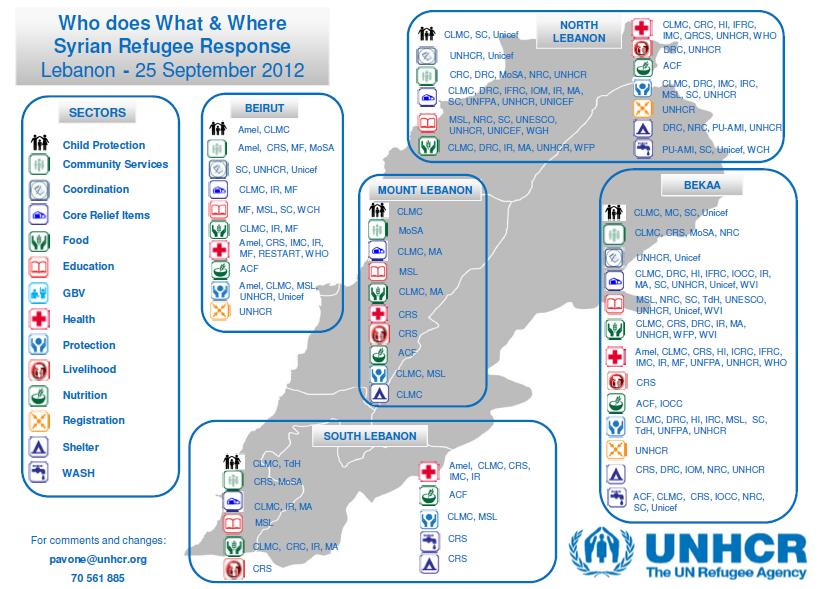What is the current status of Syrian refugees? How is the Lebanese government responding? And what still needs to be done?
In the months ahead, one of the most important challenges facing the Lebanese government will be its ability to manage the influx of Syrian refugees. Lebanon’s goal should be to fulfill its humanitarian responsibilities, while maintaining its national security and limiting socio-economic impacts on local Lebanese communities.
What is the current status of Syrian refugees?
Every day, 2,000 to 3,000 Syrians are fleeing their homes across borders into Lebanon, Jordan, Iraq and Turkey. These four countries now host more than 400,000 Syrian refugees. At this pace, the United Nations expects there to be as many as 700,000 Syrian refugees in neighboring countries by the end of this year.
In Lebanon, the number of registered refugees has now climbed to 120,906 – even higher than in Turkey – but the real total is far larger, as many choose not to register. As the Syrian conflict drags on, the number of displaced Syrians entering the country will continue to rise.
About 78 per cent of Syrian refugees in Lebanon are women and children. The majority (64%) originates from the city of Homs – the rest originate from various Syrian cities: 8% from Damascus, 7.7% from Aleppo, 7.5% from Idleb, 6% from Hama, and 6% from other cities.
Syrian refugees are distributed across Lebanon. The majority are split between the North of Lebanon (53%) and the Bekaa (42%), while the rest is spread between Beirut (1%), Mount Lebanon (2%), and the South (2%).
How is the Lebanese government responding?
The flow of Syrian refugees has been raising tensions in Lebanon. Local communities are witnessing socio-economic and security implications. Petty crimes against Lebanese citizens are on the rise. Harassment of Syrian workers in Lebanon is growing. Members of the Free Syrian Army are believed to be amongst the refugees in Lebanon. Kidnappings of Lebanese citizens in northern Syria, followed by retaliatory kidnappings of Syrians in Lebanon, have added to the tensions, as did the assassination in Beirut last month of Brig Gen Wissam al-Hassan whose death was widely blamed on the Syrian government.
The challenge of the Lebanese government is to balance between its humanitarian responsibilities, and manage the political, security, and economic risks of the Syrian refugee crisis. It is no easy feat.
The Lebanese government has been partnering with foreign governments, as well as international and local organizations to provide shelter, food, healthcare, schooling and other services to displaced Syrians.
Fifty-two humanitarian organizations are working to support the growing number of Syrian refugees. Coordinated by the United Nations High Commissioner for Refugees (UNHCR), an inter-agency regional response plan was developed in which Lebanon is a part of. The UNHCR issued an appeal for almost $500 million. To date, only 30 per cent has been funded, and Lebanon received a portion of the collected funds.
The High Relief Commission (HCR) is leading the coordination and implementation of relief efforts on behalf of the Lebanese Government. Several ministries and institutions are participating in various efforts, including the Ministry of Social Affairs, the Ministry of Education, the Ministry of Health, the Lebanese Armed Forces, and the Internal Security Forces.
What still needs to be done?
Until Syria’s conflict is resolved the flow of Syrian refugees to Lebanon will continue to grow. The success of the Lebanese government in managing the associated risks hinges on its ability to secure adequate funding and logistical support.
On the eve of winter, the Lebanese government asked donor countries to contribute an additional $450 million to help them provide for the growing number of Syrian refugees in Lebanon.
The most serious issue facing displaced Syrians in Lebanon is the issue of shelter. Lebanon is ruling out erecting refugee camps as done in Turkey, Jordan and Iraq for political reasons. Instead, other options are being considered by the Lebanese government, including using abandoned buildings as collective shelters, paying Lebanese families who are hosting Syrian refugees, and covering the rent of some of the poorest refugee families.
In conclusion, the Lebanese government’s policy should be focused on managing future threats instead of solely reacting to them. In your opinion, how should Lebanon plan to respond to the growing number of Syrian refugees on its territory?
Resources to track the Syrian Refugee Crisis:
Published Reports on the Syrian Refugee Crisis: |

